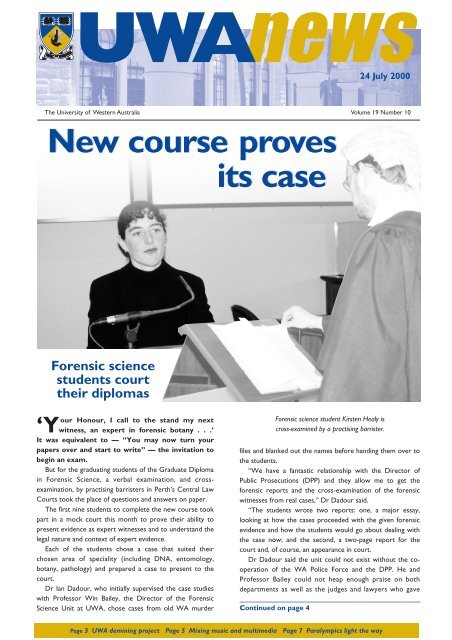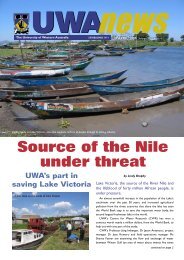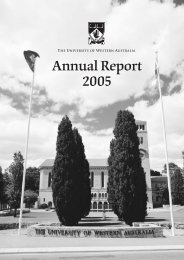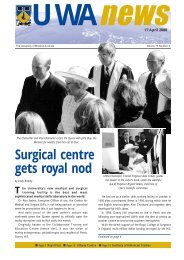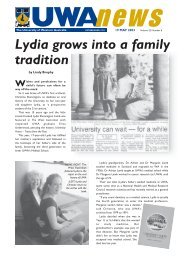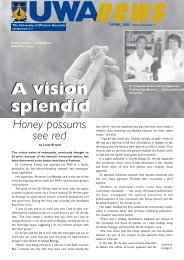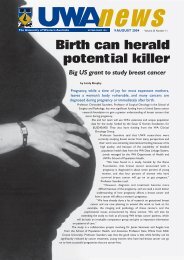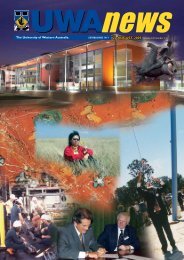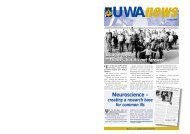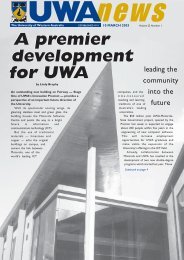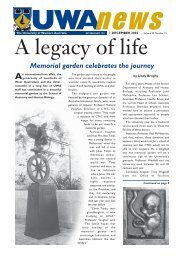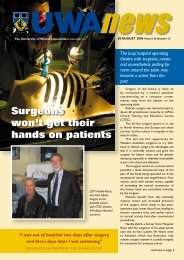July 24, 2000 - Publications Unit - The University of Western Australia
July 24, 2000 - Publications Unit - The University of Western Australia
July 24, 2000 - Publications Unit - The University of Western Australia
Create successful ePaper yourself
Turn your PDF publications into a flip-book with our unique Google optimized e-Paper software.
UWA<strong>24</strong>news<strong>July</strong> <strong>2000</strong><strong>The</strong> <strong>University</strong> <strong>of</strong> <strong>Western</strong> <strong>Australia</strong> Volume 19 Number 10New course provesits caseForensic sciencestudents courttheir diplomasour Honour, I call to the stand my next‘Ywitness, an expert in forensic botany . . .’It was equivalent to — “You may now turn yourpapers over and start to write” — the invitation tobegin an exam.But for the graduating students <strong>of</strong> the Graduate Diplomain Forensic Science, a verbal examination, and crossexamination,by practising barristers in Perth’s Central LawCourts took the place <strong>of</strong> questions and answers on paper.<strong>The</strong> first nine students to complete the new course tookpart in a mock court this month to prove their ability topresent evidence as expert witnesses and to understand thelegal nature and context <strong>of</strong> expert evidence.Each <strong>of</strong> the students chose a case that suited theirchosen area <strong>of</strong> speciality (including DNA, entomology,botany, pathology) and prepared a case to present to thecourt.Dr Ian Dadour, who initially supervised the case studieswith Pr<strong>of</strong>essor Win Bailey, the Director <strong>of</strong> the ForensicScience <strong>Unit</strong> at UWA, chose cases from old WA murderForensic science student Kirsten Healy iscross-examined by a practising barrister.files and blanked out the names before handing them over tothe students.“We have a fantastic relationship with the Director <strong>of</strong>Public Prosecutions (DPP) and they allow me to get theforensic reports and the cross-examination <strong>of</strong> the forensicwitnesses from real cases,” Dr Dadour said.“<strong>The</strong> students wrote two reports: one, a major essay,looking at how the cases proceeded with the given forensicevidence and how the students would go about dealing withthe case now; and the second, a two-page report for thecourt and, <strong>of</strong> course, an appearance in court.Dr Dadour said the unit could not exist without the cooperation<strong>of</strong> the WA Police Force and the DPP. He andPr<strong>of</strong>essor Bailey could not heap enough praise on bothdepartments as well as the judges and lawyers who gaveContinued on page 4Page 3 UWA demining project Page 5 Mixing music and multimedia Page 7 Paralympics light the way
2 UWA newsVCariousthoughts …vc@acs.uwa.edu.auNotes from the NorthThis time I determined to take the GreatNorthern Highway to the northwest. I hadalways previously taken the coastal highway viaGeraldton and the beauties <strong>of</strong> Shark Bay on theExmouth Peninsula and Coral Bay, or I had takenthe convenience <strong>of</strong> an airflight to the Pilbara.But now I had the opportunity <strong>of</strong> a week’s recreation leaveand a chance to explore that inland road and the variety <strong>of</strong>mining towns in the extraordinary landscape which the‘Great Northern’ cuts across, especially from Mount Magnetto Port Hedland.I write these notes from the Kimberley, after thatmemorable journey through the Hamersley and OpthalmiaRanges, with their amazing rocky outcrops, gorges and treeedgedhorizons. Almost like driving within one <strong>of</strong> the FredWilliams’ paintings, in his brilliantly evocative Pilbara series!Exceptional environments aside, such a journey alsoreinforces some very contemporary ideas for WA, and forour <strong>University</strong>, in this new century.Most <strong>of</strong> all what really hits home to the attentive observer isthe way in which the modern mining and energy industries— be they in Mt Magnet, or Newman, or the BurrupPeninsular — combine the extraction systems with processengineering, itself heavily dependent on the latest discoveriesand innovations in science.Compared to the world <strong>of</strong> mining sites when my father wasa mine engineer, these new industrial plants today are asmuch about the chemical sciences and high technology asthey are about the ore body itself, its extraction andcrushing; some are also manufacturing plants. This valueadding,through science and technology, is what producesthe real wealth and prosperity <strong>of</strong> WA.How good, I thought, that generic ‘science’ (and ‘high-tech’engineering) is so prominent within the UWA mission, andalso so well connected to the character <strong>of</strong> the state, in ournew draft Academic Pr<strong>of</strong>ile which identifies the key directionalareas <strong>of</strong> our research. How good too that UWA is planningto invest significantly in a major capital works projectdevoted to the chemical sciences.On a national scale I was also very pleased to read the majornew ARC Report, “Inventing Our Future: the Link Between<strong>Australia</strong>n Patenting and Basic Science”. Inspired by the nowfamous Francis Narin study in the USA, and indeed involvingNarin himself, the report shows that some 97 per cent <strong>of</strong> all<strong>Australia</strong>n research cited in <strong>Australia</strong>n invented US patents isauthored by public sector institutions. Of this figure, abouttwo thirds <strong>of</strong> the research originates at <strong>Australia</strong>nuniversities and affiliated medical research centres. Mostimportantly, the study demonstrates the strong reliance onuniversity papers in the development <strong>of</strong> private sectorpatents. <strong>The</strong>se papers are the most heavily cited resource <strong>of</strong>private companies.“Inventing our Future . . .” (to be found on the ARC website at http://www.arc.gov.au) indeed substantiates in arigorous, scholarly way what the interested traveller in thevast reaches <strong>of</strong> our state can observe. <strong>University</strong> science andengineering ultimately matters greatly. Beyond the miningindustry, it can be found in the vital knowledge agenda, inagricultural production, marine exploration and the newindustries, ranging from viticulture and winemaking to ITcompanies and the new medical applications <strong>of</strong> majorlaboratory research.We have recently hosted the national conference <strong>of</strong> the<strong>Australia</strong>n Science Teachers’ Association and it wasimportant to share these ideas with them in supporting theirimportant work in attracting more students into genericscience at school and generally propagating the excitement,let alone the importance <strong>of</strong> science, in a world increasinglyreliant on new knowledge.Of course, that world <strong>of</strong> ‘knowledge’ will also involve socialand human sciences. <strong>The</strong> new technocratic orderincorporates organisational knowledge and financialexpertise, from the social sciences, while our all too humanresponses to change and new scientific knowledge call uponthe humanities. All that can be seen in the north <strong>of</strong> our stateas well, a new society in an ancient landscape.More personally, this journey to the Pilbara and Kimberleyhas challenged my thoughts about ‘land, place, culture andidentity’, the powerful theme <strong>of</strong> an Institute <strong>of</strong> AdvancedStudies program this year.Yes, I decided, my sense <strong>of</strong> being an <strong>Australia</strong>n is deeplyaffected by the landscape. I can learn from Aboriginal ways<strong>of</strong> ‘seeing’ that environment. I can have it theorised by ourhumanities’ scholars. And I can take the Great NorthernHighway.Pr<strong>of</strong>essor Deryck M. SchreuderVice-Chancellor and PresidentTHE UNIVERSITY OF WESTERN AUSTRALIA • JULY <strong>24</strong> <strong>2000</strong>
UWA news 3Mechanical and Materials EngineeringClearing the wayfor war victims’Associate Pr<strong>of</strong>essorJames Trevelyan:a world leader indemining.For many thousands <strong>of</strong> people across the world,the end <strong>of</strong> a war is the beginning <strong>of</strong> a life <strong>of</strong>poverty, fear and uncertainty.Unexploded landmines litter more than 60 countries ineastern Europe, the Middle East, parts <strong>of</strong> Africa and Asia.For the past five years, Associate Pr<strong>of</strong>essor JamesTrevelyan, from the Department <strong>of</strong> Mechanical andMaterials Engineering, has been working on finding thesimplest solutions for ridding these people <strong>of</strong> the potentiallylethal mines that not only pose a constant threat <strong>of</strong> deathand injury but prevent local communities from using theirland and their resources.“Casualties continue atunacceptable levels . . . the costsare still far beyond the resourcescurrently available . . . ”UWA’s Demining Project has come up with low costmethods and equipment for improving the detection andremoval <strong>of</strong> mines and the safety and comfort <strong>of</strong> thedeminers.Associate Pr<strong>of</strong>essor Trevelyan is now a world leader inthe area <strong>of</strong> demining.He was recently a keynote speaker at an internationalmeeting in Geneva <strong>of</strong> the Standing Committee <strong>of</strong> Experts onTechnologies for Mine Action. It was part <strong>of</strong> a seriesproviding a response to the Ottawa Landmines Convention.He said that donor countries (like <strong>Australia</strong> and the US)needed to invest in machinery to help manual deminers andmine detection dogs, and to better protective equipmentand human resource development to improve clearanceefforts.“Casualties continue at unacceptable levels and manymore countries are asking for assistance for clearance. <strong>The</strong>costs are still far beyond the resources currently available,”Associate Pr<strong>of</strong>essor Trevelyan said.futureHe also said that much <strong>of</strong> the on-going research effort indeveloped countries could be more effective: theperformance <strong>of</strong> mine detection dogs and quality controlwere the top priorities for deminers.“<strong>The</strong> long sought-after ‘plastic mine’ detector wouldhelp, but not as much as a method for remotely locatingmine and unexploded ordnance contamination. Manycountries have large tracts <strong>of</strong> land where people suspectthere are mines and unexploded shells, but no one knowswhere. If we knew how to locate contamination, the rest <strong>of</strong>the land could be used much sooner,” he said.As well as developing better protective equipment andtraining mines, to help deminers learn the necessary skills,the UWA research project has been documenting thetechnical problems that deminers face in many countries.Associate Pr<strong>of</strong>essor Trevelyan and his colleagues havedocumented problems in Afghanistan, Angola, BosniaHerzegovina, Croatia, Egypt, Iraq, Jordan and Lebanon inthe past 12 months.He hopes to start a research effort into the training <strong>of</strong>mine detection dogs, with UWA zoologist and dogbehaviour expert Dr Ian McLean.Continued Some <strong>of</strong> the on debris page 4fromexploded mines,unearthed by deminers.THE UNIVERSITY OF WESTERN AUSTRALIA • JULY <strong>24</strong> <strong>2000</strong>
4 UWA newsNew course provesits caseContinued from page 1up their time to hear the mootcases and cross-examine thestudents.Judges Shauna Deane and PaulHealy each gave a day to sit on thecases.Pr<strong>of</strong>essor Bailey said the ninegraduates were already in work. Twowere serving members <strong>of</strong> the WAPolice Force (working in the forensicarea but wanting pr<strong>of</strong>essional training),and another is in training at the PoliceAcademy. Others have work with thePathCentre and the Federal Police.“We want more lawyers and policeto do the course. It’s especiallyimportant to lay juries that forensicexperts can show their qualifications.Cases like Lindy Chamberlain’s swungon the ‘pieces <strong>of</strong> paper’ produced byforensic experts who were brought inby the defence from overseas. <strong>The</strong>prosecution didn’t have those ‘pieces<strong>of</strong> paper’ to prove their expertise and“It’s especially important tolay juries that forensicexperts can show theirqualifications . . . theprosecution (in the LindyChamberlain case) didn’thave those ‘pieces <strong>of</strong> paper’to prove their expertise andthat case failed the<strong>Australia</strong>n public . . .”ABOVE: Executive Dean, Pr<strong>of</strong>essor GeorgeStewart and Pr<strong>of</strong>essor Win Bailey at thecourthouse.LEFT: Dr Ian Dadour, supervising thecase studies with Pr<strong>of</strong>essor Win Bailey.that case failed the <strong>Australia</strong>n public,”Dr Dadour said.About 30 UWA staff, from five out<strong>of</strong> the six faculties, contribute to theGraduate Diploma in Forensic Science.<strong>The</strong> unit also links with the <strong>University</strong>’sCrime Research Centre and usesexpertise from the PathCentre, CSIRO,the Chemistry Centre and AgricultureWA.As well as the graduate diploma(equivalent to one year <strong>of</strong> full-timestudy), the unit also <strong>of</strong>fers a master’sdegree in forensic science (two years<strong>of</strong> full-time study).Clearing the way for war victims’ future Continued from page 3<strong>The</strong>re are currently no availablemeasurements on mine detection dogperformance, although dogs have beenused, with some degree <strong>of</strong> success.Recent failures by dogs in BosniaHerzegovina have caused great concern.Associate Pr<strong>of</strong>essor Trevelyan’swork in Lebanon has helped to drawinternational attention to the mineproblems there, where casualty ratesexceed levels in Bosnia and Croatia.“<strong>The</strong> recent withdrawal <strong>of</strong> Israeliforces will enable Lebanon to startclearance operations in the south <strong>of</strong> thecountry.“However, they will need assistancefor this work. Israeli authorities haveundertaken to provide locations <strong>of</strong> theminefields their forces laid, butexperience in Jordan shows that evenprecisely located minefields pose hugeproblems for deminers,” he said.An Afghan deminer uses his dog to sniff out buried mines.RIGHT: Project <strong>of</strong>ficerSabbia Tilli with theprotective suit,designed to protectAfghan deminers whoprefer to squat as theywork in the field.THE UNIVERSITY OF WESTERN AUSTRALIA • JULY <strong>24</strong> <strong>2000</strong>
UWA news 5Mixingmusicandmulti-mediaWorking in tune to improve musical understanding — Dr Sam Leong and Dr Martin Lamb.When Sam Leong and Martin Lamb sit down atthe piano together, they improvise beautifulmusic — effortlessly. “That’s because we are in tunewith each other’s minds,” explains Dr Leong.Teaching music students to be attuned to the minds <strong>of</strong>other musicians is one <strong>of</strong> the aims <strong>of</strong> a unique project inwhich they are both involved.<strong>The</strong> idea is to bring togethercomputers and music in aninnovative multimedia s<strong>of</strong>twarepackage, and to use it to trainstudents by helping them findnew and better ways <strong>of</strong> learning.International s<strong>of</strong>tware consultantDr Martin Lamb, whospecialises in creating music, maths and science s<strong>of</strong>tware, hascome to UWA from Toronto to work on the ambitiousproject with Dr Sam Leong, senior lecturer and Director <strong>of</strong>Music Education Studies.“We want to put together a research-based teaching andlearning package, complemented by multimedia s<strong>of</strong>tware,that will teach music students to look at the ways theylearn,” says Dr Leong.“<strong>The</strong> aim is to identify which learning strategies are beingused, and how effective they are. <strong>The</strong> next step will be todevelop alternative strategies and see whether they work better.“<strong>The</strong> challenge is to incorporate the strategies into thes<strong>of</strong>tware. It is a tall order because everybody’s brain isdifferent.” And, as Dr Leong points out, the s<strong>of</strong>tware is just“We want to put together a researchbasedteaching and learning package,complemented by multimedia s<strong>of</strong>tware,that will teach music students to look atthe ways they learn”one element <strong>of</strong> the program, “because s<strong>of</strong>tware can neverever replace a teacher”.In training the ear to music, students are taught toanalyse what they hear, and describe it intelligently — a vitalskill for the complete musician. “For example, if you areplaying in an orchestra and lose your place, these skills willhelp you find it again before theconductor has noticed,” saysDr Lamb.“<strong>The</strong>y deepen musicalappreciation, help musicians towrite down what they hear,enable them to look at a piece<strong>of</strong> music with greater understandingand be able tocommunicate its meaning better than someone who simplylearns which notes to play.”As Dr Leong has already developed a catalogue <strong>of</strong>strategies that his students have been trying out, thechallenge is now to encapsulate them into a program.Because the aim <strong>of</strong> the project is to encourage studentsto think about how they learn, and to develop new learningstrategies, it <strong>of</strong>fers potential spin-<strong>of</strong>fs into other disciplines.<strong>The</strong> joint venture is headed by UWA (through theSchool <strong>of</strong> Music and the Arts Faculty Multimedia Centre), inpartnership with the Universities <strong>of</strong> Adelaide andNewcastle. <strong>The</strong> funding, $140,000 over two years, isprovided through a CUTSD (Committee for <strong>University</strong>Teaching and Staff Development) grant.THE UNIVERSITY OF WESTERN AUSTRALIA • JULY <strong>24</strong> <strong>2000</strong>
6 UWA newsHow do you rate your working life?Ethicsand your well-being are two new areas to be included in the Working Life Survey <strong>2000</strong>.All UWA staff should have received their survey forms a few weeks ago and everybody isurged to take the time to fill them in and return them by the beginning <strong>of</strong> August.Information gathered in the survey is valuable for planning over the next few years. <strong>The</strong> results willindicate what areas need improvement and identify a range <strong>of</strong> issues to feature in future enterprisebargaining agreements.Human Resources’ senior policy analyst, Jan Stuart, said the most important indication from the1997 Working Life Survey was a powerful need for job security among UWA staff.“We have focused on that in the latest enterprise agreement,” Ms Stuart said.She said that efforts have been made to reduce repetition and improve the coherence, especiallythe section on the working environment.Other areas have been expanded, including new sections on ethics and your well-being, and thequestions on equity have been altered.In reworking the survey, Ms Stuart and her team in Human Resources have included questions thatwill facilitate comparison with other surveys.Questions about choosing an academic career or choosing to work in higher education have comefrom the American Faculty Poll, a regular survey <strong>of</strong> Americans working in higher education. UWA canbenefit from comparing its staff’s attitudes to those in similar positions overseas.A few questions from a national ARC-funded stress survey in higher education (due out in August)are included in this Working Life Survey, also for comparisons, as are some questions from a survey<strong>of</strong> academics in <strong>Australia</strong>n universities on work roles, and questions from polls conducted by theNational Health Service in the UK and the WA Public Service.“We have included these so we can identify our position in relation to other institutions in ourown state, in other parts <strong>of</strong> the country and internationally,” Ms Stuart said.<strong>The</strong> over-riding feeling expressed by staff in the 1997 survey was a positive one about UWA, thatit was a good place to work and they were reasonably happy at work.“This was confirmed by the exit statements provided by staff who have left the <strong>University</strong> sincethe last survey,” Ms Stuart said. But the rapidly changing environment for higher education may haveresulted in changes. We need to be aware <strong>of</strong> these movements.“It is important that as many staff as possible find the half an hour needed to respond to thissurvey, so we are best equipped to make the decisions or changes that YOU want.”Looking for genuine bargains? Forget thedepartment stores and boutiquesand stay on campus.<strong>The</strong> UWA Save the Children Fundbooksale is in its final days in the undercr<strong>of</strong>t<strong>of</strong> Winthrop Hall.While the rare gems are likely to havebeen already snapped up, the tables are stillBook in for a bargainbeing replenished and the prices are plummeting. Asorganiser Rosalind Lindsay says, “Everybodygoes out smiling on the last day” when youcan fill a box for just a few dollars.<strong>The</strong> sale is open until 7.30pm tonight andtomorrow (Monday and Tuesday) and thedoors close on the last happy customer at2pm on Wednesday. Enquiries: 9381 3423.THE UNIVERSITY OF WESTERN AUSTRALIA • JULY <strong>24</strong> <strong>2000</strong>
UWA news 7Centre for Offshore Foundation SystemsWA holds the last surprisefor worldly engineerDr Barry Lehane . . . surprised byearthquakes.Civil engineer Barry Lehanehas led design teams workingon the Hong Kong–Kowloontunnel, a new underground raillink across London and gravityplatforms in the North Sea.He thought there could be no moreengineering surprises in store for him— until he came to UWA.<strong>The</strong> Gledden Senior Fellow fromTrinity College, Dublin, spent firstsemester working with Pr<strong>of</strong>essor MarkRandolph, Director <strong>of</strong> the Centre forOffshore Foundation Systems (COFS),and Associate Pr<strong>of</strong>essor Martin Fahey,Head <strong>of</strong> the Department <strong>of</strong> Civil andResource Engineering, on designmethods for foundation systems.Dr Lehane said he was surprised t<strong>of</strong>ind that every structure in WA has tobe built with the possibility <strong>of</strong>earthquakes in mind.“<strong>The</strong>re is quite a severe earthquakeloading, something which I’m not usedto. We have no seismicity at all inDublin!” he said.“<strong>The</strong> world is such a small placenow that I would have said there wereno surprises to be found in technology,methods and design <strong>of</strong> foundationstructures, no matter where in theworld you were. <strong>The</strong>n I learned about<strong>Western</strong> <strong>Australia</strong>’s earthquakes.”<strong>The</strong> brilliant young engineer whotopped his class at <strong>University</strong> College,Cork, is now a lecturer in civil engineeringat Trinity College and a Fellow<strong>of</strong> the College, as well as chairman <strong>of</strong>the Geotechnical Society <strong>of</strong> Ireland anda core member <strong>of</strong> the EuropeanTechnical Committee on Piles.“About 50 per cent <strong>of</strong> my researchis involved with piled foundations andthe design approach for them,” he said.“Design differs from theory in thatit’s more practical. My particular skill isin bridging the gap between the crazyideas that academics have and thereality <strong>of</strong> practical engineering.“Of course, I’m not referring to theacademics here! COFS has an internationalreputation for always being intouch with industry. That’s why Idecided to come here.”He said that exploration companieswere having to drill deeper to find oiland gas and this presented a challengeto people like himself and COFS.“Our understanding <strong>of</strong> soil behaviouris improving all the time, so weneed to keep changing our designs.”Dr Lehane said designing foundationsfor <strong>of</strong>fshore structures was notmuch different from those for onshoreuse.“A thousand metres <strong>of</strong> waterdoesn’t make much more difference tothe soils and movements within themthan one meter <strong>of</strong> water. And allowingfor wave motion in the structure issimilar to allowing for wind instructures on land,” he said.For KerrySmith, theOlympic TorchRelay was just apractice run for the real thing.For Mrs Smith, the co-ordinator <strong>of</strong>Unigym, in the Department <strong>of</strong> HumanMovement and Exercise Science, thereal Olympics are the Paralympics,which will follow the competitions forable-bodied athletes.She has been chosen to carry thetorch in the Paralympic Torch Relay onOctober 8.Her son David, swam in the 1992Paralympics and she was a staffHuman Movement and Exercise ScienceParalympics light the waymember at the Barcelona Games. MrsSmith is the sports director <strong>of</strong> the WAParalympic Committee and pastpresident <strong>of</strong> the WA Disabled SportsAssociation.She has been involved in paralympicsand sports for people with disabilitiessince they began in WA. She is onseveral state, national and internationalcommittees and it is for her untiringwork for people with disabilities thatshe is being rewarded with a leg <strong>of</strong> thetorch relay.Earlier this month, Human Movementgraduate Scott Walker returnedfrom his work with a motor racingcompany in France to carry theOlympic torch for a leg <strong>of</strong> the relay inJoondalup.Mr Walker has represented<strong>Australia</strong> at two Olympicgames in bobsleigh butafter a master’s thesis,which examinedproblems formotorsportathletes, heis now workingin thefield he lovesmost, the motorracing industry.THE UNIVERSITY OF WESTERN AUSTRALIA • JULY <strong>24</strong> <strong>2000</strong>
8 UWA newsPMRG — Perth Medieval andRenaissance Group Ninth Conference“Writing People, Writing Places inMedieval and Early Modern Europe”9am to 5pm, <strong>University</strong> House, Saturday August 59.30 to 10.45am: Dr Emma Hawkes (History) — “IsabellePlumpton: a life in law”Peter Little (History) — “Absent with leave: identifying theoccasional armies <strong>of</strong> late medieval England”11.05 to 11.35am: Bruce McClintock — “Scripting the holy:saints’ lives”11.35am to 12.50pm: Dr Amanda Capern (<strong>University</strong> <strong>of</strong> Hull)“Women, property and family relations in early modern England”1.50 to 2.50pm: Gina Goddard (English) — “MargaretCavendish”Dr Brad Menpes — “Aspiring to Divine Zenocrate: Marlowe’sMyth <strong>of</strong> Timur the Lame in Tamburlaine”3.10 to 4.10pm: Helen Bermingham (Italian and English) — “Aspirit <strong>of</strong> Venice: the unique voice <strong>of</strong> Gaspara Stampa in earlymodern poetry”Jennifer Smith (History) — “Writing bodies, writing spaces: theOccitan Lyric”4.15pm: Book Launch Andrew Marvell, edited by David Ormerodand Christopher Wortham. Entertainment by Sneak’s Noise.Conference fee (incl. c<strong>of</strong>fee on arrival, morning tea, lunch andafternoon tea) is $30 or $20 for full-time students’concession.Enrolment forms are available from the Department <strong>of</strong>fices <strong>of</strong>English and History and should be forwarded with payment toEmma Hawkes, c/o Dept. <strong>of</strong> History by Friday <strong>July</strong> 28.CENTRE FOR STAFF DEVELOPMENTWhat’s on NextPlaces are available in the following workshops due toclose within the next month. Further details areavailable on the CSD Web page:http://www.csd.uwa.edu.au/programme/or by contacting CSD on ext. 1504 orcsd<strong>of</strong>fice@csd.uwa.edu.au• Flexible Teaching and Learning:What Is It? How Can It Help Me?• <strong>The</strong> Experienced Committee Secretary• Handling the Media Confidently• Equity and Diversity Issues within theHigher Education Environment• Introduction to Management• Designing (or re-designing) Your <strong>Unit</strong>• Using the <strong>University</strong>’s Accounting System:Budget Process• Using the <strong>University</strong>’s Accounting System:Mastercard — Corporate and PurchasingTHE UNIVERSITY OF WESTERN AUSTRALIA • JULY <strong>24</strong> <strong>2000</strong>
UWA news 9Saturday 29 <strong>July</strong>UWANews is published fortnightly. Information for thepublication dated August 7 should be forwarded toJoanna Thompson, <strong>Publications</strong> <strong>Unit</strong>, ext 3029, fax 1162,email: uwanews@publishing.uwa.edu.auNO LATER THAN 5PM ON JULY 26Media enquiries to Public Affairs on 9380 2889.Unless a restricted audience or charge is specified, allthe events/exhibitions listed here are free and open toall and may attract media interest.Monday <strong>24</strong> <strong>July</strong>ASTHMA AND ALLERGY RESEARCH INSTITUTE SEMINAR“What statistical reviewers are looking for in journal articles”,Kieran McCaul. 12.30 to 1.30pm, Joske Seminar Room, Medicine,Fourth Floor, G Block, SCGH.Tuesday 25 <strong>July</strong>LAWRENCE WILSON ART GALLERY FLOORTALK“A fortunate life: John Rose speaks about Albert Facey.” 1pm,LWAG.THE FRED ALEXANDER LECTURE <strong>2000</strong>“Historical carnival <strong>of</strong> reconciliation: commemorating the SouthAfrican War 1899-1902”, Dr Jane Carruthers, Department <strong>of</strong>History, <strong>University</strong> <strong>of</strong> South Africa. 1pm, Fox Lecture <strong>The</strong>atre.Wednesday 26 <strong>July</strong>ENVIRONMENTAL ENGINEERING DYNAMICS SEMINAR“Ineffective natural attenuation <strong>of</strong> degradable organic compoundsin a phenol-contaminated aquifer”, David Lerner, GroundwaterProtection and Restoration Group, <strong>University</strong> <strong>of</strong> Sheffield, UK.4pm, Blakers Lecture Room, Ground Floor, Mathematics Building.PHYSIOLOGY SEMINAR“Iron absorption in the light <strong>of</strong> recently discovered genes”, Dr PhilOates, Physiology. 5pm, Physiology Seminar Room.Thursday 27 <strong>July</strong>ENVIRONMENTAL ENGINEERING DYNAMICS SEMINAR“Long-term environmental load distributions: influence <strong>of</strong> platformconfiguration”, Pr<strong>of</strong>essor Beverley Ronalds, Centre for Oil andGas Engineering. 4pm, Blakers Lecture Room, MathematicsBuilding.Friday 28 <strong>July</strong>ANTHROPOLOGY SEMINAR“Invented tradition: from pinkie fingers to graveside customs inmodern Israeli behaviour”, Dr Sam Cooper, Anthropology, BarIlan <strong>University</strong>, Israel. 12 to 1pm, Anthropology ConferenceRoom, First Floor, Social Sciences Building.BIOCHEMISTRY SEMINAR“Molecular regulation <strong>of</strong> Apoptosis”, Associate Pr<strong>of</strong>essor Dharma,Anatomy and Human Biology. 1pm, Simmonds Lecture <strong>The</strong>atre.CIVIL AND RESOURCE ENGINEERING SEMINAR“Rigorous plasticity solutions for the bearing capacity <strong>of</strong> <strong>of</strong>fshorefoundations”, Dr Chris Martin. 3.45pm, Room E151, First Floor,Civil Engineering Building.BRACK SYMPOSIUM (INCORPORATINGSALEK MINC LECTURE)<strong>The</strong> Lawrence Wilson Art Gallery is pleased to hold the BrackSymposium, a day <strong>of</strong> talks about the art <strong>of</strong> John Brack, whichcelebrates the new exhibition being held at LWAG between <strong>July</strong>and September — John Brack: Inside and Outside, a National Gallery<strong>of</strong> <strong>Australia</strong> travelling exhibition. <strong>The</strong> symposium will also includethe annual Salek Minc Lecture given by Helen Brack. For bookingsor further information call 9380 3707.Monday 31 <strong>July</strong>HISTORY SEMINAR“<strong>The</strong>sis disaster stories”, Anna Hicks and Joanna Sassoon. 4.30pm,Postgraduate Lounge, Hackett Hall.PUBLIC LECTURE/INSTITUTE OF ADVANCED STUDIES“Einstein: his scientific and humanitarian legacy”, Pr<strong>of</strong>essorHanoch Gutfreund, Pr<strong>of</strong>essor <strong>of</strong> Physics, Immediate PastPresident, <strong>The</strong> Hebrew <strong>University</strong> <strong>of</strong> Jerusalem. Pr<strong>of</strong>essorGutfreund is on a speaking tour <strong>of</strong> <strong>Australia</strong> in preparation forfuture exhibitions in Melbourne, Sydney and Perth <strong>of</strong> materialsfrom the Einstein Archives at the Hebrew <strong>University</strong> <strong>of</strong> Jerusalem.Clinical Pr<strong>of</strong>essor and Chancellor Alex Cohen will introduce thelecture. 5.30pm, Lawrence Wilson Art Gallery. All Welcome.RSVP on ext. 2114 or tawhite@cyllene.uwa.edu.au.Tuesday 1 AugustSOIL SCIENCE AND PLANT NUTRITION SEMINAR“<strong>The</strong> use <strong>of</strong> cover crops to decrease nitrate leaching from arablesoils”, Andrew McDonald, Department <strong>of</strong> Soil Science, IACRRothamsted. 4pm, Agriculture Lecture <strong>The</strong>atre.Friday 4 AugustANTHROPOLOGY SEMINAR“<strong>The</strong> pragmatics and politics <strong>of</strong> tradition and identity”, Pr<strong>of</strong>essorRobert Tonkinson. 12 to 1pm, Anthropology Conference Room,First Floor, Social Sciences Building.CIVIL AND RESOURCE ENGINEERING SEMINAR“<strong>The</strong> simplified numerical analysis <strong>of</strong> thin-walled tubular piles”,Shunqing Cai. 3.45pm, Room E151, First Floor, Civil EngineeringBuilding.Saturday 5 AugustAUSTRALIAN STRING QUARTET PERFOMANCE<strong>Australia</strong>’s premier chamber music ensemble presents a programthat includes Schubert’s Death and the Maiden and Roger Smalley’snewly commissioned Second Quartet. 8pm, Winthrop Hall.Monday 7 AugustASTHMA AND ALLERGY RESEARCH INSTITUTE SEMINAR“FACS: advanced cell sorting techniques”, Dr Matthew Wikstrom.12.30 to 1.30pm, Joske Seminar Room, Medicine, Fourth Floor, GBlock, SCGH.ADVANCE NOTICETuesday 8 AugustSOIL SCIENCE AND PLANT NUTRITION/CENTRE FORLAND REHABILITATION SEMINAR“Why dryland and water salinisation are still major environmentalproblems”, Elizabeth Kington. 4pm, Agriculture Lecture <strong>The</strong>atre.UWA DISTINGUISHED LECTURE SERIES IN SCIENCE,PHILOSOPHY AND RELIGION“Creationism and sociobiology: towards a new morality?”Pr<strong>of</strong>essor David Hull, Dressler Pr<strong>of</strong>essor in the Humanities atNorthwestern <strong>University</strong>, Illinois. Pr<strong>of</strong>essor Hull will beintroduced by Pr<strong>of</strong>essor Deryck Schreuder. 8pm, Social SciencesLecture <strong>The</strong>atre.THE UNIVERSITY OF WESTERN AUSTRALIA • JULY <strong>24</strong> <strong>2000</strong>
10 UWA newsInstitute <strong>of</strong> Advanced StudiesUgly ingredients increating a President“If you can come through this horrible processalive, you are probably in fairly good shape totake on the <strong>of</strong>fice <strong>of</strong> President . . .”n ugly horrendous process in‘A an almost manic, inhumancampaign.’<strong>The</strong> words <strong>of</strong> visiting Americanpolitical scientist Alan J. Ward, describingnot civil war or ethnic cleansing,but the US Presidential election.Pr<strong>of</strong>essor <strong>of</strong> Government at theCollege <strong>of</strong> William and Mary in Virginia,and Visiting Pr<strong>of</strong>essor <strong>of</strong> AmericanStudies at Flinders <strong>University</strong>, Pr<strong>of</strong>essorWard says he is glad to be out <strong>of</strong>America (at Flinders) during theelection campaign.He relayed his special interest inhow and why Americans electPresidents as they do and whether theprocess, in the end, puts the best manin the White House, at a recent lectureat UWA.He said the long and expensivecampaigns were not what the foundingfathers intended.“<strong>The</strong>y didn’t like popular passionsand the position <strong>of</strong> President was notdesigned to be a popularly elected<strong>of</strong>fice,” Pr<strong>of</strong>essor Ward said.But money — hundreds <strong>of</strong> millions<strong>of</strong> US dollars — has changed all that.“Entrepreneurial campaigns haveopened up the race for the Presidencyto anybody. <strong>The</strong>re are 11 people standingfor President this year and nine <strong>of</strong>them believe they have a chance <strong>of</strong>winning.“Jimmy Carter proved in 1976 thatjust about anybody could win!”Pr<strong>of</strong>essor Alan J. Ward speaking at theDolphin <strong>The</strong>atre.Pr<strong>of</strong>essor Ward explained thesystem <strong>of</strong> primary campaigns in eachstate which chooses the eventualcontenders. <strong>The</strong> winner <strong>of</strong> eachprimary takes all the votes from thatarea to the national vote.Over the past 20 years, only 50 percent <strong>of</strong> registered voters have actuallyvoted in a Presidential election.Pr<strong>of</strong>essor Ward says it is impossible totell what proportion <strong>of</strong> eligible votersthat represents.“So it is possible to eventuallybecome President with something like30 per cent <strong>of</strong> the eligible votes, asRonald Reagan did, or even the high20s, like Bill Clinton.”He said political parties in the USwere weak, compared to the system in<strong>Australia</strong> and, during the Presidentialelection, become little more than fundraisingauxiliaries.<strong>The</strong> 50 states all have separatepowers and the President doesn’tdepend on the support <strong>of</strong> Congress, asthe <strong>Australia</strong>n Prime Minister needsthe support <strong>of</strong> the House <strong>of</strong>Representatives, to survive.“Every candidate faces the task <strong>of</strong>running a primary in at least 40states, each <strong>of</strong> them with differentrules and regulations. <strong>The</strong> congestionand complexity makes campaigningalmost manic, inhuman,”Pr<strong>of</strong>essor Ward said.<strong>The</strong> campaigns are dominated byTV and the much-cited Fifth Amendmentto the Constitution (which upholdsfreedom <strong>of</strong> speech) will not allowlimits on spending.Some Presidential hopefuls can raise$5 million and find it’s not enough anddrop out <strong>of</strong> the race. Up until Marchthis year, candidates had already spent$280 million — and that’s declaredexpenditure only — with severalmonths still to go.As for whether the process puts thebest man in the White House: “If youcan come through this horrible processalive, you are probably in fairly goodshape to take on the <strong>of</strong>fice <strong>of</strong>President,” Pr<strong>of</strong>essor Ward said.And his predictions for the currentcampaign?“It’s really too close to call at thisstage. But I feel Gore may win becauseGeorge Bush is reasonably shallow and Ithink this will show through in a closeelection. My feeling is that Al Gore isbetter informed and will outperformBush in the debates.”THE UNIVERSITY OF WESTERN AUSTRALIA • JULY <strong>24</strong> <strong>2000</strong>
UWA news 11School <strong>of</strong> DentistryMaking yoursmile moreappealing . . .You might not wish to know that the materialsused in tooth fillings today — while matched tothe colour <strong>of</strong> your teeth — are not as long-lasting asthe silver amalgams <strong>of</strong> old.While they undoubtedly make your smile more appealing,they do have problems, and considerable research iscurrently going into improving the quality <strong>of</strong> dentalcomposites, as they are known.Visiting US researcher Pr<strong>of</strong>essor Jack Ferracane (picturedright), from the School <strong>of</strong> Dentistry at the Oregon HealthSciences <strong>University</strong>, explained that although the materialshave been around for almost 30 years, and manyimprovements have been made during that time, dentalcomposites used for aesthetic reasons still have limitations.<strong>The</strong>y were originally designed for use in the most visiblefront teeth, but as the big push in dentistry today is inaesthetics, they are becoming more commonplace.Pr<strong>of</strong>essor Ferracane said one <strong>of</strong> the main problems wasdurability. As the fillings harden from paste to solid they areinclined to shrink, which can prevent them from adheringproperly to the tooth wall. “A lot <strong>of</strong> research is being doneinto understanding how shrinkage occurs and how to reduceit.”Tooth-coloured fillings are more expensive and difficultto insert than the old amalgams. Another problem is thatwhen these materials are inserted in teeth that are subjectedto regular stress they are not as strong as silver amalgams.“We are looking at the wear and abrasion <strong>of</strong> these materialsand how to make them more resistant.”Pr<strong>of</strong>essor Ferracane said that although concerns havebeen expressed Young about the Aboriginal dangers dancers <strong>of</strong> mercury wait in forsilverfillings, such fears their are unfounded turn to perform. as the levels are too low tobe toxic.As the <strong>2000</strong> A. J. Herman Fellow, Pr<strong>of</strong>essor Ferracane isin Perth to deliver the A. J. Herman lecture, present a paperat the International Association for Dental Research <strong>2000</strong>Conference held at UWA, and lecture to staff and studentsat the School <strong>of</strong> Dentistry.Centre for <strong>Western</strong> <strong>Australia</strong>n HistoryNow in s<strong>of</strong>t cover: On <strong>The</strong> HomefrontRecently released in s<strong>of</strong>t cover version by UWA Press is a book commemorating thecontributions and sacrifices made by <strong>Western</strong> <strong>Australia</strong>ns in World War II.On <strong>The</strong> Homefront: <strong>Western</strong> <strong>Australia</strong> and World War II, which was shortlisted for theWA Premier’s Special Book Award 1997 and the NSW Premier’s Community andRegional History Award in 1998, examines how ordinary people responded to the warand its aftermath.Edited by Dr Jenny Gregory, academic, historian and Director <strong>of</strong> UWA Press, the bookincorporates the work <strong>of</strong> 23 historians, bringing together the largest group ever towork on a single historical project in WA. <strong>The</strong>y included retired senior lecturer PenHetherington, retired psychology lecturer and writer Ron Davidson, AssociatePr<strong>of</strong>essor Tony Barker and ex-doctoral students from the Department <strong>of</strong> History.On <strong>The</strong> Homefront is currently in use in secondary schools and as a text for a UWAhistory unit. It is available at the UWA Visitor’s Centre.THE UNIVERSITY OF WESTERN AUSTRALIA • JULY <strong>24</strong> <strong>2000</strong>
12 UWA newsDepartment <strong>of</strong> PathologyGolf aidsbreast cancerresearchBev Jackson is a woman <strong>of</strong> unlimited enthusiasm.As a member <strong>of</strong> the Zonta International Peel Club,she is the driving force behind a unique campaign inwhich funds for breast cancer research are raisedthrough golf tournaments. By cajoling, harassing, andbrowbeating businesses, corporations, pr<strong>of</strong>essionalgolfers and individuals, Bev almost single-handedlypersuades them to support Zonta’s annual fund-raiser —a nine-hole mixed tournament at the Pinjarra Golf Club.This year, after the ninth-hole had been completed inthe tournament in February, money was raised throughan auction <strong>of</strong> donated goods and services, ably conductedby Arthur Marshall, MLA for Dawesville.To date, the group has raised more than $32,000 fromthis annual event, and the money has enabled theDepartment <strong>of</strong> Pathology to buy vital items <strong>of</strong> equipmentincluding their newest acquisition — a researchmicroscope.To acknowledge Zonta’s generous contributions toresearch into breast cancer, the department recentlyheld a special ceremony at which Club President JoyceO’Loughin was presented with a mounted cover <strong>of</strong> theJournal <strong>of</strong> Cell Biology, which features an article by researchstaff using image analysis equipment bought by thedepartment with money raised by Zonta.Bev Jackson using the new research microscope.Centre for Women and BusinessNew focusforresearchingwomenin businessWhile women in business and the pr<strong>of</strong>essionshave made real advances over recentdecades, they still lag behind men in achievingdecision-making positions, resulting in many leavingthe corporate arena to run their own businesses.To provide a focus for research aimed at giving smallbusiness and the corporate world a better understanding <strong>of</strong>the issues involved, the Centre for Women and Business hasbeen established as part <strong>of</strong> the Graduate School <strong>of</strong>Management.For Centre Director Pr<strong>of</strong>essor Leonie Still, the priority isto promote public debate about issues relating to women inwork, and the barriers preventing them from achieving theirfull potential.<strong>The</strong> trend towards running their own businesses is notnecessarily an adverse one but it does have limitations, saysPr<strong>of</strong>essor Still. “Thirty-five per cent <strong>of</strong> small operators arenow women and the rate is accelerating. Many are escapeesfrom the corporate world, tired <strong>of</strong> not achieving theirambitions, and <strong>of</strong> conforming to a masculine culture.<strong>The</strong>y want to do things differently — to combine socialand economic goals, value honesty and integrity, look aftercustomers, and make a contribution to the community.(Many men have the same goals, but perhaps not to thesame degree.)Most women keep their businesses small, working ontheir own or with a few employees, in order to keepcontrol and avoid being bought out by a partner. Onelimitation is that they tend not to grow their businesses;instead they start another small enterprise, and thus becomeserial business owners. “<strong>The</strong>y do it quite successfully,” saysPr<strong>of</strong>essor Still “<strong>The</strong> limitations, if you use the male model,are that we are not producing women who will build multinationals,they don’t want to reach for the sky as men do.”Women are also limited in the types <strong>of</strong> business they run,tending to focus on the service area, as opposed tomanufacturing, which needs venture capital.“What is very pleasing,” says Pr<strong>of</strong>essor Still, “is thatyoung women don’t have these limitations. <strong>The</strong>ir approachis, ‘I can do anything’. <strong>The</strong>y invest in themselves and theirown entrepreneurial abilities, and they are proving they canattract venture capital.”TOP PHOTO: Catherine Ferrari (left), new CEO <strong>of</strong> theWA Symphony Orchestra, with Kate Lamont,winemaker and restauranteur.THE UNIVERSITY OF WESTERN AUSTRALIA • JULY <strong>24</strong> <strong>2000</strong>
UWA news 13Diversity Initiatives Fund <strong>2000</strong>Do you have an idea for a project you wouldlike to implement which would advance the<strong>University</strong>’s equity and diversity goals?If so, now is the time to do something about it.<strong>The</strong> <strong>University</strong> has allocated funding for equityprojects. Grants are available to individuals or groups forprojects that contribute to and advance the <strong>University</strong>’sequity and equal opportunity objectives.<strong>The</strong> grants can be used to develop new projects or toassist in the continuation or expansion <strong>of</strong> existingprojects. <strong>The</strong> projects can be related to research,teaching, curriculum, provision <strong>of</strong> services for students,staff issues or other areas.A small committee will assess the applications anddetermine which projects will receive funding against alist <strong>of</strong> criteria that have been developed taking intoaccount level <strong>of</strong> need, impact <strong>of</strong> the project and thedegree to which they contribute to the <strong>University</strong>’sequity and equal opportunity goals.Application forms and further details have been sentto executive deans, heads <strong>of</strong> departments and the Guild.Please contact Malcolm at the Equity Office on 93802252 if you have any queries, or see our web page at thefollowing address: http://www.acs.uwa.edu.au/hrs/equity/Applications will close on Friday 31 <strong>July</strong> <strong>2000</strong>.Initiatives funded in 1999 included:• Enhancing the access, participation and outcomes <strong>of</strong>women into Academic Surgery, Faculty <strong>of</strong> Medicine andDentistry;• Mentoring scheme for new staff from culturally diversebackgrounds, Centre for Staff Development;• Improve support structures for non-English speakingbackground women postgraduate students in the Faculty<strong>of</strong> Agriculture;• Increasing employment opportunities and equity forpeople with disabilities, Human Resources;• Rural and Isolated Students Recruitment and Supportproject — Arts and Science.THE UNIVERSITY OF WESTERN AUSTRALIA • JULY <strong>24</strong> <strong>2000</strong>
14 UWA newsCLASSIFIEDSFOR RENTRENOVATED FREMANTLE COTTAGE, forshort-term lease, fully furnished, study, cosylounge/formal dining room, modern bathroomand quality kitchen opening onto large sundeck.Available at $250p/w for approx. 9 weeks fromend <strong>of</strong> <strong>July</strong> while owners travel overseas.Contact Rehlein on 9336 7684.HOUSE IN CARLISLE available for rent inSeptember to mid-October. Close to bus andtrain, fully furnished, suit visiting academic withfamily. Phone Jen de Vries on 9361 4990 oremail jdevries@csd.uwa.edu.au.FOR SALEHOLIDAYING IN THESOUTHWEST?Go 'first class' at BroadwaterBeach Resort, three B/R lux. unitwith heated pool, spa, tenniscourt, privately owned, specialrate; or cedarwood chalets inbush setting on Blackwood River,two adults only, perfect peaceand tranquillity. Pay two nights,stay three.Bookings: 0427 522 334 or9752 2896Advertising RatesFull page $550Half page $275Quarter page $137.50Eighth page $88Sixteenth page $71.50Rates are GST inclusive.All bookings toJoanna Thompson, <strong>Publications</strong> <strong>Unit</strong>Phone: 9380 3029; Fax: 9380 1162HOLIDAY CHALET, KALBARRI. Two-bedrooms,fully furnished, holiday chalet in strata complex <strong>of</strong>22. Currently owned by UWA. $69,500. ContactMike at WACRRM on 9384 2811.CAMRY SILVER (1989), reliable and in excellentcondition. $4500. Contact John on 9335 4734.CAMRY (1998), white, 43,000km, auto, PS, CL,under new warranty until mid-2001. Excellentcondition. $19,500 ono. Call Sharon on ext.2562 or 9305 3736.COROLLA SEDAN, 1991, white, fully imported,diesal, auto, air-con, power steering, factorytinted windows, stereo/tape deck, exc. cond.,reliable and economical. $8500. Contact Lornaon ext. 3976 or 9250 3835 (a/h).KB LASER HATCHBACK (1985), white, reliableand in good condition. $2750. Contact Carolineat home on 9387 1471.UWAEmployeeAssistanceProgram<strong>The</strong>re are times when all <strong>of</strong> us have challengingissues to deal with. When personal or work relatedissues make life difficult, the <strong>University</strong> has anEmployee Assistance Program (EAP) to help staffmanage these issues more effectively.<strong>The</strong> EAP is a pr<strong>of</strong>essional, confidential counsellingand consultation service. <strong>The</strong> services <strong>of</strong> DavidsonTrahaire are available FREE to you and your familyfor up to six sessions a year.For appointments, please ring Davidson Trahaireon 9382 8100 or if urgent 9480 4847(<strong>24</strong> hours).<strong>The</strong>ir <strong>of</strong>fices are located at Suite 11, 100 Hay St,Subiaco. Further information can be obtained atwww.admin.uwa.edu.au/shoRedundant Equipment for SaleITEM PRICE AGE CONDITION DEPT. CONTACTComputer desks, adjustable heightmechanism (8 only), successful biddersto arrange own pick up and delivery Offers 5 2-3 Library recoleman@library.uwa.edu.au4 PC’s (Not Y2K complaint)3NX, 66 MHz, 16 Mb Ram,404 Mb H/Disk Offers 6 3 Agric. & Res. Econ. 2530Micro Arts 100 MHz,48 Mb Ram, 840 Mb H/Disk Offers 5 3NetPro 155 MHz, 32 Mb Ram,1 Gb H/Disk Offers 4 3Netpro 155 MHz, 32 Mb Ram,1 Gb H/Disk Offers 4 3Box only, Netpro 150 MHz,32 Mb Ram, 1.2 Gb H/Disk Offers 4 3IBM Laser Printer 4039 10R,by Lexmark (Prints double-sided) Offers — 3 International Centre 3941over $100Richo Fax 500/550, not working/serviceable, incl. operators manual — — — Child Care Centre 9389 94333 x Power Mac 7200/75 $600 each — 2 Medical Centre 2118Power Mac 7 7100/66AV $450 — 2Power Mac 6100/60 $300` — 3Mac Performa 5400 $450 — 2Apple LaserWriter II $200 — 3Mac LC630 (no screen) $100 — 2Avtek MegaModem 336 $50 — 2Canon Elec. Typewriter Offers — 2Label Printer for Mac $100 — 2QuickTake 150 Digital Camera Offers — 2Apple Laptop $500 — —Bids should be accepted by Monday August 7 with departments to have first optionDepartments are reminded that all <strong>University</strong> equipment available for sale must be advertised in the UWA News. Receipts should be PeopleS<strong>of</strong>t accountcoded 490 (computing with barcode), 491 (non-computing with barcode) or 493 (items with no barcode). If equipment has an existing barcode pleasecontact extension 3618/2547 for details.CONDITION refers to the general condition <strong>of</strong> item (1 = as new; 2 = good; 3 = serviceable; 4 = unserviceable). AGE refers to the nearest year.THE UNIVERSITY OF WESTERN AUSTRALIA • JULY <strong>24</strong> <strong>2000</strong>
UWA news 15ARC STRATEGIC PARTNERSHIPS WITHIND-RESEARCH/TRAINING (SPIRT)• Dr Michael Edmund Tobar and Dr EugeneNickoli Ivanov, Physics, and Mr J. H. Searls(external): “Compact High-Q Microwave Braggresonators” — $49,390 (<strong>2000</strong>/01).• Mr Thomas Meier and A/Pr<strong>of</strong> King Ngi Ngan,Electrical and Electronic Engineering, Dr W. Liand Dr X. Zhang (external): “Real-time contentbased video coding for multimedia communications”— $63,577 (<strong>2000</strong>); $56,192 (2001);$58,003 (2002).• Dr Brenton Knott, Zoology, Dr Julie LorraineDelaney, Geography, Pr<strong>of</strong> Jorg Imberger, Centrefor Water Research, and Pr<strong>of</strong> M. McGregor(external): “Research programme into <strong>Western</strong><strong>Australia</strong>n Salt Lake Biota” — $42,160 (<strong>2000</strong>/01/02).• Dr David Philip Hamilton, Dr Charitha BandulaPattiaratchi, Environmental Engineering, and MrM. S. Robb (external): “Salt wedge propagationand biochemical composition in two West<strong>Australia</strong>n estuaries and implications for waterquality management using oxygenation” —$70,000 (<strong>2000</strong>); $50,000 (2001); $45,000 (2002).• Pr<strong>of</strong> Krishnapilla Sivasithamparam, Soil Scienceand Plant Nutrition, A/Pr<strong>of</strong> John Jin-Su Kuo,Microscopy and Microanalysis, and Dr K. W.Dixon (external): “<strong>The</strong> role <strong>of</strong> mycorrhizalinteractions in the urban ecology, managementand restoration <strong>of</strong> terrestial orchids” — $57,000(<strong>2000</strong>/01/02).• Dr Mark Emmerson Barley, Dr Bryan Krapezand Dr Mark Ge<strong>of</strong>frey Doyle, Geology andGeophysics: “Volcanic and hydrothermalinfluences on the genesis <strong>of</strong> banded ironformations, Hamersley Group, <strong>Western</strong><strong>Australia</strong>” — $54,377 (<strong>2000</strong>); $56,192 (2001).AUSTRALIAN RESEARCH COUNCIL• Pr<strong>of</strong> Sandra Eleanor Bowdler, Anthropology:“An archaeological study <strong>of</strong> pre-Europeannortheast Tasmania” — $22,000 (<strong>2000</strong>); $20,000(2001); $29,500 (2002).• A/Pr<strong>of</strong> Lynette Kay Abbott, Soil Science andPlant Nutrition “Impact <strong>of</strong> phosphorus uptake bycommunities <strong>of</strong> arbuscular mycorrhizal fungi onjarrah forest understorey plants” — $57,000(<strong>2000</strong>); $58,000 (2001/02).Research&GrantsContracts• Dr Zed Rengel, Soil Science and PlantNutrition: “Regulation <strong>of</strong> manganese transportinto developing lupin seed” — $33,000 (<strong>2000</strong>);$30,100 (2001); $32,000 (2002).AUSTRALIAN RESEARCH COUNCIL —SMALL GRANTS• Dr Gregory Alan Crebbin, Electrical andElectronic Engineering: “Analogue imagesegmentation with applications in robot visionand video coding” — $6476 (<strong>2000</strong>).• Dr Paul Albert Fournier, Human Movementand Exercise Science, and Pr<strong>of</strong> T. N. Palmer,(external): “Diet-dependent patterns <strong>of</strong> lactatedisposal and glycogen resynthesis in animalsrecovering from high intensity physical activity”— $7000.• Dr P. Clement, Environmental Engineering:“Experimental and numerical investigation <strong>of</strong>unconfined flow systems with seepage-faceboundaries” — $13,170.• Dr Marie Ann Bogoyevitch, Biochemistry:“Identification <strong>of</strong> high affinity binding partners forphosphorylated tyrosine 763 <strong>of</strong> the granulocytecolony stimulating factor receptor” — $7000.• Pr<strong>of</strong> Michael John McAleer, Economics“Modelling financial returns and risk in thepresence <strong>of</strong> extreme observations” — $8872.• Dr Karin Ann Eidne, Medicine: “Novelchaperone proteins involved in the folding andtrafficking <strong>of</strong> G-proteins coupled receptors” —$5000.• Dr Phillip Stephen Oates and Pr<strong>of</strong> EvanMorgan, Physiology: “<strong>The</strong> role <strong>of</strong> divalent metaltransporter and HFE in iron absorption” —$9000.• Dr Rosalie Dianne McCauley, Surgery:“Metabolism <strong>of</strong> the amido nitrogen group <strong>of</strong>glutamine within enterocytes” — $7000.CANCER FOUNDATION OF WA• A/Pr<strong>of</strong> Konrad David Jamrozik, Public Health,and Dr D. J. Joseph and Dr M. J. Byrne(external): “National colon cancer care survey”— $50,000.COMMONWEALTH DEPARTMENT OFTHE ENVIRONMENT• Miss D. R. Newbound, Zoology: “Parasiticcopepods as biological tags for whale sharkmigration” — $7000 (<strong>2000</strong>); $1000 (2001).DEPARTMENT OF TRANSPORT• Dr Gerald Anthony Ryan and Ms Lucia RinaCercarelli, Public Health, and Dr N. Haworth(external): Tender: “Feasibility study into thedetermination <strong>of</strong> fatigue related crashes” —$22,900.IAN POTTER FOUNDATION• Dr Suzanne Irene Wijsman, Music: “Travel:<strong>2000</strong> International Musicological Symposium,Budapest” — $1000.JUVENILE DIABETES FOUNDATIONINTERNATIONAL• A/Pr<strong>of</strong> Piroska Rakoczy, Ophthalmology andVisual Science, and A/Pr<strong>of</strong> N. Della (external):“Development <strong>of</strong> a treatment for diabeticretinopathy by inhibition <strong>of</strong> the underlyingmechanism <strong>of</strong> neovascularisation using genetherapy” — $175,678.Watch out for moreResearch Grantsand Contractsin the next issue<strong>of</strong> UWA News.UWAnewsEDITOR/FEATURE STORY WRITERLindy BrophyTel.: 9380 <strong>24</strong>36 Fax: 9380 1192Email: lindy.brophy@uwa.edu.auCallKenataRentalsand book a one, two or three bedroom townhome absolutelyfully equipped with everything! Short or long stay. From $350per week, including all amenities.Location: cnr Fairway and Edward Streets, Crawley (oppositeMechanical Engineering)Enquiries: 0412 953 100 or fax 9389 8326Kenata Rentals providing short term, fully furnished accommodation to UWA since 1982.CAMPUS DIARY/ADVERTISING/CLASSIFIEDS/REDUNDANT EQUIPMENT/DISTRIBUTION LISTJo ThompsonTel.: 9380 3029 Fax: 9380 1162Email: uwanews@publishing.uwa.edu.auDesigned and produced by<strong>Publications</strong> <strong>Unit</strong><strong>The</strong> <strong>University</strong> <strong>of</strong> <strong>Western</strong> <strong>Australia</strong>Printed byUniprint<strong>The</strong> <strong>University</strong> <strong>of</strong> <strong>Western</strong> <strong>Australia</strong>UWAnews onlinehttp://www.publishing.uwa.edu.au/uwanews/EDITOR-IN-CHIEF/PUBLIC AFFAIRSColin Campbell-FraserTel.: 9380 2889 Fax: 9380 1020Email: cam@acs.uwa.edu.auTHE UNIVERSITY OF WESTERN AUSTRALIA • JULY <strong>24</strong> <strong>2000</strong>
...the last word16 UWA newsSponsorship = Partnershipand RelationshipWhen it comes to sponsorship the mainthing to realise is that it is not about money.It is about relationship and partnership. It is aboutthe parties having an agreement which brings themmutual benefit. Without mutual benefit therelationship will not continue.<strong>The</strong> sponsorship relationship is about people and humaninteraction and it is always a great pleasure working with theQantas Marketing Manager Justine Bell-Morris and her team.When people <strong>of</strong>ten talk about wanting sponsorship they seeit only as a means <strong>of</strong> improving the cash flow for a plannedevent or conference. In todays changing world you have tolook at what you tangibly have to <strong>of</strong>fer the other party. Howdo you make it a valuable relationship for them to beengaged in.Qantas has been a long-term partner with UWA Extensionin a relationship which started with <strong>Australia</strong>n Airlines nineyears ago. Over that timethe nature <strong>of</strong> therelationship has changedby mutual agreement.<strong>The</strong> benefits for UWAExtension has beenaccess to travel which facilitates our being able to bring inmajor public speakers. <strong>The</strong> benefits for Qantas are brochurepromotion but more importantly access for their staff toattend the wide range <strong>of</strong> developmental opportunities ourcourses <strong>of</strong>fer.UWA Extension is planning to increase our range <strong>of</strong>sponsorship partners and the model we will be following isthat which has developed with Qantas.<strong>The</strong> key to sponsorship is to think not <strong>of</strong> what they can d<strong>of</strong>or you, but what you can do for them.Kim D. Roberts, Director, UWA ExtensionMarketing strategies for a competitive marketplaceNo longer is advertising and marketing a onedimensionalmedium — it’s not enough in thecurrent competitive environment to rely on thetraditional means <strong>of</strong> promoting your services andwinning new business through an advertisingcampaign.With ever-increasing competition within a competitivemarketplace, marketeers have become strategic and targetedin their promotional and advertisingstrategies.Companies are sponsoring organisationsand events that will <strong>of</strong>fer both a uniqueway to promote their company’s servicesand fit their overall marketing strategy.When approaching potential sponsors dosome background research on thecompany. <strong>The</strong> questions that need to beasked are:• How does our organisation/event suitthe marketing strategies <strong>of</strong> the companywe are approaching for sponsorship?<strong>of</strong>fer any direct benefit, (in the case <strong>of</strong> an airline, can we<strong>of</strong>fer any travel revenue)?• Do we have other sponsors who do business with thecompany we are approaching? Do we have opportunitiesfor this company to network with potential clients?Qantas and UWA Extension have had a relationship forover five years. We have worked together to create asponsorship that benefits both parties.This year we value-added the sponsorship, extending it toour employees, giving them the opportunity to be involvedwith UWA Extensions courses. By doing this we haveinternally created good will amongst our staff. By involvingour staff in our sponsorship we are fostering a unitybetween UWA Extension and the various departmentswithin Qantas Perth.In summary, if you wish to approach corporations forsponsorship, do your homework — don’t assume youknow what’s best for them. Take some time and tailormake the proposal to suit the individual company,understand their objectives and,above all, be innovative.• Does our image fit in with the imagethe company is trying or has created?• What can we <strong>of</strong>fer the company otherthan branding and hospitality; can weJustine Bell-MorrisMarketing ManagerQantasTHE UNIVERSITY OF WESTERN AUSTRALIA • JULY <strong>24</strong> <strong>2000</strong>


